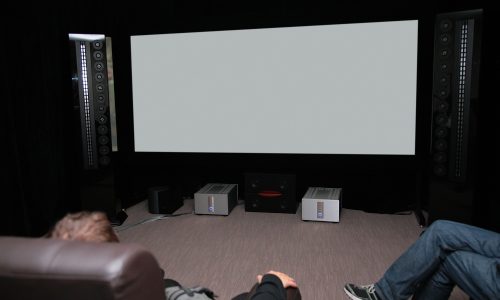Watching media on a projection screen in a home theater is a little like holding a fine glass of wine in your hand, according to David Rodgers, marketing manager for Elite Screens. It needs to savored, and to do so, you need to make sure the projector screen itself is positioned at the right height and distance from the audience. Of course, you also should make sure you have the perfect projector as well.
“Viewing a home theater projection screen is a ‘sensual’ experience just like fine wine. You don’t drink wine like water; you savor it. And you don’t hold your wineglass by the bowl or rim. You hold the base or stem so that there are no unsightly fingerprints on the glass and your fingertips don’t warm the vintage wine beyond its optimal tasting temperature,” says Rodgers.
“It’s not entirely about seeing the film. It’s not even entirely about seeing the film with superb dynamic range, optimal color saturation and D65 color temperature. The physical comfort of your body while watching a film should be equally as important as the picture quality itself,” he says.
With that in mind, Rodgers offers a some quick tips on how to find the perfect projector screen position when watching movies or shows.
Finding the Perfect Projector Screen Height
There’s two things to keep in mind when positioning a projector screen in a room, the first having to do with how high the viewer will be seated and how high the ceiling of the room is. Obviously, if the projection screen is too big or small for the room it’s being placed in, you’re going to have a rough time achieving that perfect viewing height, so make sure you get the right-sized projector screen first before trying to position it.
Then, if you follow these two steps, you’ll be able to find the perfect projector screen height for viewing audiences.
Step 1. Make Sure the Viewer’s Head is Level
Start by making sure that the viewer’s head is comfortably level. The average person’s eyes are between 42 and 50 inches from the floor when seated, as such, a safe “sweet spot” to work with is to assume about a 48-inch average for everyone.
You can also use either a tape measure or laser pointer to get a more accurate read on where a specific person’s eye level will be when seated by having them sit down at the intended viewing spot and running out a tape measure or placing a laser pointer to the back and side of the head. Just make sure you don’t accidentally blind anyone with the laser.
Step 2. Follow the Lower One-Third of the Screen Rule
This is the golden rule of any projector screen install (and really any television screen install for that matter). The viewer’s eye level should align with the boundary line between the top two-thirds and bottom one-third of the screen. With eyes aligned one-third of the way up on the screen, the least amount of eye, head or neck movement is required for the viewer to take in everything happening on the screen. If the viewer’s eye level is 48 inches, this should also align with the bottom one-third measurement of the screen’s height.
A Properly Positioned Screen is the Key to Comfort and Picture Fidelity
Comfort and perception greatly enhances the viewing experience. A properly mounted screen prevents the viewer from encountering perceived visual distortion. The image appears naturally as a person’s eyes would see it in real time. It also prevents unnecessary neck and eye fatigue from disrupting your ability to sit through the feature presentation.
By following these quick steps while setting up your projector screen, you can be sure to land on the perfect height and positioning, ensuring that you’re able to get best visual experience out of your investment.


















